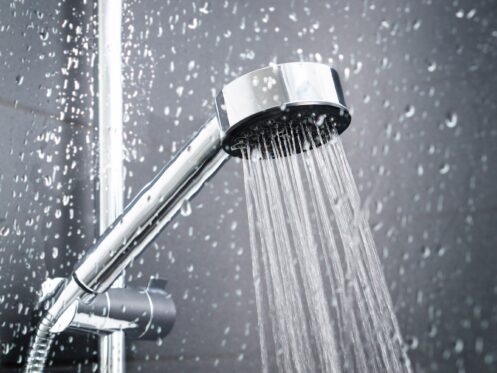Most people don’t think about water pressure until something starts banging in the pipes or the shower goes from a blast to a trickle. Water pressure that’s too high can damage plumbing, while too low pressure can be frustrating. A water pressure regulator might help, but not every home needs one.
At Pure Plumbing in Dallas, TX, we help homeowners determine when this small device can make a big difference. Before you decide whether it’s worth installing, it helps to understand what a regulator does and how to tell if your system needs some balance.
What a Water Pressure Regulator Does
A water pressure regulator sits near your main shut-off valve, usually where water enters your home. Its job is to manage how hard water pushes through your pipes. It’s a simple valve with an internal spring that compresses or relaxes depending on how much force comes through the line. If pressure gets too high, the regulator reduces it to a steady, manageable level. This protects your pipes, appliances, and fixtures from stress.
Most homes are designed to work best with pressure between 40 and 60 psi. If water enters your house much faster than that, you might hear pipes knock, see faucets spit, or notice toilets running longer than they should. The regulator doesn’t completely stop water flow. It slows it down enough to help your system handle the pressure more safely and consistently. That means fewer leaks, less wear, and a longer life for everything connected to your plumbing.
Signs That Your Water Pressure is Too High
You probably don’t walk around measuring water pressure every day. But high pressure has a way of showing up in small ways that add up. You might hear a banging sound when you turn a faucet off. This is called water hammer, which happens when water stops suddenly and hits the inside of your pipes.
Toilets may fill quickly and then run louder than usual. You may notice that your dishwasher sounds harsher or your washing machine jolts more when it starts. Another clue is if your garden hose bursts at the connection or sprays more than expected.
Sometimes, water pressure is only slightly high, but it stays that way all day. That constant pressure wears out seals, rubber washers, and valve components inside appliances. If you’ve had to replace a dishwasher valve or water heater part more than once, it could be the water pressure, not the appliance, that’s to blame.
Why Low Flow Doesn’t Always Mean You’re Safe
It’s easy to assume that your pressure must be low if you don’t have a strong blast from your faucet. But low flow doesn’t always mean low pressure. Sediment buildup, clogged pipes, or blocked aerators can slow water down even if the pressure in the line stays high.
If a regulator fails or gets stuck, it may not respond properly, leaving you with uneven water behavior throughout the day. That means you could get a trickle in the bathroom and still have high-pressure blasting through to your water heater—the danger there is hidden wear. Pipes might expand or shift under pressure while your fixtures show no usual warning signs, leading to damage and leaks that require pipe or sewer repair.
Checking pressure with a gauge matters more than guessing based on your shower’s strength. You can’t always trust your plumbing to stay balanced without knowing the pressure inside your system. Our plumbers use specialized gauges to get an accurate measure.
What Happens When Pressure Stays Too High
High water pressure is not just an inconvenience. It creates real strain on your plumbing. Pipes shift slightly every time water flows through them. With high pressure, that movement becomes stronger and more sudden. Over time, this movement weakens pipe joints, causes pinhole leaks, or breaks seals around fittings. Water heaters experience extra stress, too.
High pressure means water fills the tank quickly, sometimes forcing hot water out faster. That leads to temperature swings or even early failure of internal components. In toilets, valves wear out more quickly, and minor leaks around the base may start to appear. If your home has older copper or galvanized pipes, the constant push of high pressure can speed up corrosion inside the walls.
Unfortunately, that kind of internal damage doesn’t always appear until you’re dealing with a soaked ceiling or warped flooring. By slowing down the flow to a stable level, a pressure regulator gives your system a better chance to last longer and perform more reliably.
Do All Homes Need a Water Pressure Regulator?
Not every home has a pressure regulator installed, and not every house needs one added. If your incoming water pressure stays within a healthy range and your plumbing runs without symptoms, you might not need one immediately. However, many homes receive water from municipal systems that fluctuate, especially during off-peak hours or after line repairs. If your faucets feel more forceful at night or early in the morning, that might mean your pressure varies throughout the day.
Homes that sit near the bottom of a hill or close to a main water line often get higher pressure than homes further away. That’s just how gravity and system design work. Even if your plumbing seems fine now, sudden changes in supply lines, like a nearby construction project or water main update, can bump pressure up unexpectedly. In that case, a pressure regulator acts like a buffer, absorbing spikes before they hit your home’s pipes.
How to Tell if Your Regulator Isn’t Working Right
Most pressure regulators last between 7 and 12 years, depending on the quality of the water and how much stress the system handles. If you’ve lived in your home for a while and never replaced it, there’s a chance it might not be working the way it should.
Pay attention to any water pressure inconsistency. If you feel pressure jumps from room to room or hour to hour, your regulator may not adjust as it should. In the worst-case scenario, you might not notice until something leaks or bursts. Getting your pressure checked once a year, especially in an older home, can help you catch problems before they get expensive.
Installation and Maintenance: What to Expect
Adding a water pressure regulator isn’t complicated, but it does need to be done carefully. The existing pipe may need to be cut to fit the regulator, and the water will be turned off briefly during the job. Once in place, the valve can be adjusted to your preferred pressure setting, usually between 50 and 60 psi for most homes. After installation, you shouldn’t need to adjust it. It operates quietly in the background, doing its job without much attention.
However, like any mechanical part, it doesn’t last forever. It could be time for a replacement if you hear a humming or whistling noise near your main water line or notice pressure swings. Regular plumbing system inspections and maintenance help catch those issues early, especially if you’ve recently changed your plumbing system or added new appliances that rely on stable pressure.
Fix Your Water Pressure with a Regulator Today
Water pressure might not seem like a big deal, but too much or too little can affect your appliances and the longevity of your plumbing system. A little control can go a long way in terms of long-term comfort and protection. If you’re ready to get your pressure right, Pure Plumbing can help you take the next step. We offer complete plumbing services, including installations and emergency plumbing repair.
Call us today for water pressure problems or any other plumbing issue.

